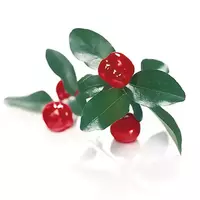Barbadian acerola cherry

The Barbadian cherry acerol or Malpighia glabra belongs to the plant genus Malpigia. In its biological structure, and in addition to its appearance, the Barbadian cherry of acerol is a fruit tree, growing mainly in the region of South America. Interestingly, the Barbadian cherry of acerol differs in the content in its chemical composition of a sufficiently large amount of vitamin C.
Thanks to this distinctive property, Barbadian cherry or acerol has earned special honor and respect among the inhabitants of South America, where the plant has been cultivated for quite a long time. The tropical evergreen acerol tree, as a rule, does not exceed 6 meters in height. Elliptical leaves do not exceed 7 cm in length and 4 cm in width.
The fruit of Acerola has a rounded shape and resembles those well known to the vast majority of the inhabitants of our cherry latitudes. However, the Barbadian cherry has a slightly flattened shape. Inside the fruits of acerola is a juicy acidic flesh with hard seeds. As the name implies, the birthplace of the Barbadian Acerol cherry is the island of Barbados.
However, not only the gardens of this paradise tropical island grow incredibly useful for human health cherries of acerol. Barbados cherry grows in all the small Antilles. In addition, Barbadian acerol cherries are cultivated in Jamaica, in the US state of Florida and Texas, in Bermuda and the Bahamas, as well as in Ghana and Australia.
The fruits of Barbados cherries are eaten both fresh and dried. Fresh fruits of Barbados cherries are used to make fruit salads, desserts and baking fillings. We can say that Barbadian cherries are used in the same way as the fruits of our usual ordinary cherries. Especially popular are jams, syrups and jam made from the fruits of Barbadian cherries.
As a result of research, it was found that some varieties of the Barbadian cherry plant contain up to 3300 mg of vitamin C in their fruits, which are per 100 grams of fruit. The Barbadian cherry acerola is almost 100 times higher than the vitamin C content in such a well-known source of this vitamin as orange.
In addition, the chemical composition of Barbadian cherries is enriched with vitamins of group B, E, K, A and beta-carotene. Regular consumption of the fruits of Barbadian cherries helps to cleanse the body of harmful substances, as well as heavy metals. The fruits of Barbadian cherries, due to the distinctive properties of the plant, have been used by islanders in their folk medicine for many centuries. It is believed that Barbadian cherry helps to increase immunity, and in addition to support the body after severe viral diseases.
Barbados Acerol Cherry 23 kCal
Energy value of Barbadian cherry acerol (Ratio of proteins, fats, carbohydrates - ju):
Proteins: 0.4 g (~ 2 kCal)
Fats: 0.3 g (~ 3 kCal)
Carbohydrates: 4.5 g (~ 18 kCal)
Energy ratio (bj | y): 7% | 12% | 78%
 Español
Español Français
Français Português
Português Русский
Русский 简体中文
简体中文 繁體中文
繁體中文 日本語
日本語 한국어
한국어 العربية
العربية Türkçe
Türkçe Қазақ
Қазақ Deutsch
Deutsch Italiano
Italiano Українська
Українська
